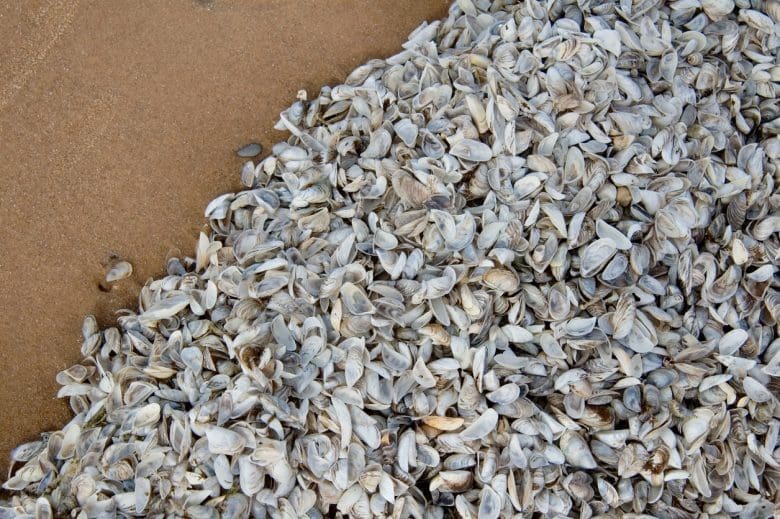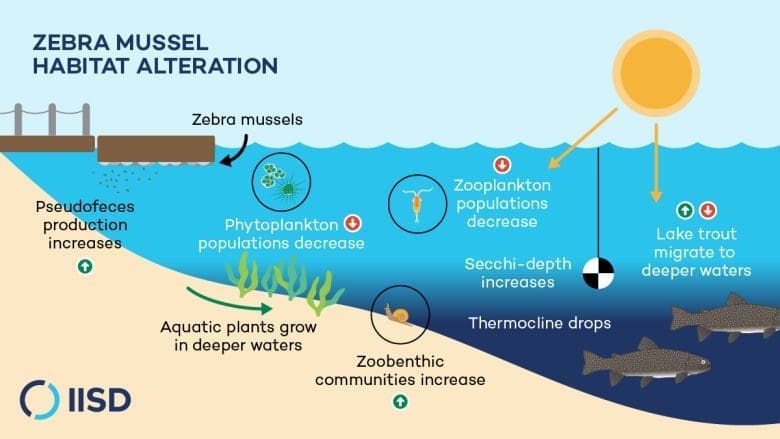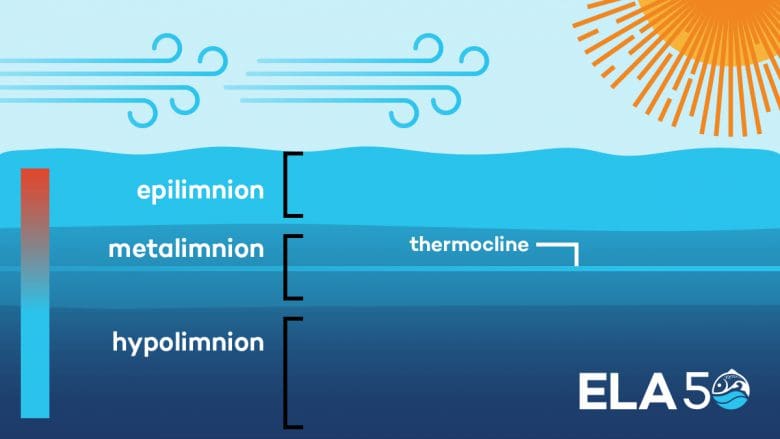Back to Basics September 15, 2021
BACK TO BASICS: This Is What Zebra Mussels Do to a Lake
By Julia Kozak
Zebra mussels have proven to be an extremely effective competitor in non-native environments and can severely alter the aquatic ecosystems they live in.
This invasive species can also be classified as an ecosystem engineer since it impacts the physical, chemical, and biotic aspects of its environment.
Their presence also has the potential to economically impact human resources and interests; in Canada alone, they cause millions of dollars in damage each year.
What Are Zebra Mussels?
The zebra mussel (Dreissena polymorpha) is a small, often striped, freshwater mollusc native to the Ponto-Caspian basin in Eastern Europe. Despite their small size, zebra mussels can reach population densities of thousands of individuals per square metre and can have large impacts on their surroundings when introduced into non-native freshwater environments.
Zebra mussels were first detected in Canadian waterways within Lake Erie in 1986 and they have since spread throughout all of the Laurentian Great Lakes. Zebra mussels were subsequently detected within the south basin of Lake Winnipeg in 2013, most likely having been introduced from the Red River, where they were later detected.
Zebra mussels are extremely effective filter feeders, meaning that due to their larger population sizes they can filter much more water than native freshwater mussels. As a result, they can be effective at removing particles, including algae (a food source for higher trophic levels), causing a cascading set of impacts to nearly all other biota (including fish) within the lakes and rivers they invade. Unlike native mussels, zebra mussels and other taxa in their genus, like quagga mussels, can colonize and foul hard surfaces such as rocks, docks, and other infrastructure. Zebra mussels also colonize the shells of native mussels, often to such an extent that they smother native mussels and prevent efficient feeding. A general rule of thumb is that native mussel communities decline by approximately 90% within 10 years after zebra mussels invade. Given their remarkable capacity to alter their surroundings and, often entire ecosystems, they are often referred to as invasive ecosystem engineers.
An ecosystem engineer: an organism that directly or indirectly manipulates resources within an ecosystem by altering biotic or abiotic components. They have the potential to modify, create, maintain, or destroy integral components of a habitat, which will affect other organisms within the ecosystem.

Why Should YOU Care?
The zebra mussel has proven to be a successful invader primarily due to its ability to utilize human vectors (such as recreational watercraft and boat trailers), to move between lakes, and an extremely high fecundity and reproductive output which results in exponential population growth. Zebra mussels can attach and foul hard surfaces (rocks, pipes, boats, other mussels, clogging intake pipes and watercraft, fouling beaches and in some cases reduce populations.
So, What Does That Mean to You?
Since zebra mussels are equipped to attach themselves to any hard and stable surface, this means that most human-made products are susceptible to mussel attachment. Watercraft propellers and engines have frequently been the victims of zebra mussel infestations, which often result in the boat being damaged due to mussel blockage and aggregation. Power generating stations, water treatment plants, and other human infrastructure experience millions of dollars in damage due to zebra mussels clogging pipes and other water intake structures.
Also, your cabin experience might be totally ruined.
The shells of dead zebra mussels frequently wash up on beaches en masse, cutting the feet of swimmers and beachgoers with their sharp shells. Since zebra mussels also manipulate water clarity and nutrients, they can lead to excessive growth of plants and benthic algae within nearshore areas. These areas of decaying algal material provides a habitat for potentially harmful bacteria. Some fish populations are also at risk of decreasing, meaning that there will be fewer fish for recreational angling. All these effects have the potential to reduce the value of waterfront properties, as externalities resulting from zebra mussel infestation continue.

Altering Ecosystems: How do they do it?
The presence of zebra mussels in a non-native aquatic environment can cause a series of interrelated chain reactions. As a direct result of their biological functions, activities, and mere presence, zebra mussels can alter trophic community compositions and affect the transfer of energy within aquatic food webs.

- Zebra mussels are filter feeders that consume phytoplankton and other particulate matter (such as nutrients) from the water column, which reduces phytoplankton populations. Zebra mussels within Lake Erie and Lake Huron have been found to promote blue-green algal blooms because they selectively reject these types of phytoplankton.
- When favourable phytoplankton species are removed from the water, zooplankton populations decrease as their main food source disappears.
- By filtering out all phytoplankton and suspended matter, zebra mussels can significantly improve water clarity (Secchi-depth). Comparative Secchi-depth measurements from 1988–1989 showed that water clarity increased by 85% within Lake Erie and by 50% in Lake St. Clair—higher than any depth recorded before the mussel invasion.
- Sunlight can penetrate deeper into the lake because water clarity has improved. When water within the upper layers (the epilimnion) are clearer, it allows sunlight to warm deeper parts of the lake that would otherwise not have received any sunlight. This causes the thermocline to drop, as the water within the upper layers become much warmer, decreasing available habitat for cool-water fish populations, such as lake trout.

- If a zebra mussel does consume unfavourable types of phytoplankton, it will release pseudofeces back into the environment.
- Sunlight penetration at greater depths and nutrient-rich deposits (courtesy of continual pseudofeces) allows aquatic plants to spread and grow much deeper than was previously possible. This creates a positive habitat for zoobenthic organisms, which promotes their population growth.
- Fish species that feed solely on zoobenthic organisms might experience an increase in population, while fish species that feed on zooplankton organisms might experience a decrease in population. If a fish species feeds on both types of organisms, its population might fluctuate.
Pseudofeces are mucus-bound particles containing viable nutrients that have been rejected by the zebra mussel’s body and reintroduced back into the environment. When released into the sediment, aquatic plant growth and zooplankton populations become stimulated.
What Happens Next: The food web
Once zebra mussels have altered physical, chemical, and biological aspects of an aquatic environment, this can disrupt the natural flow of energy within a food web.
Zebra mussels outcompete other aquatic organisms that also feed on phytoplankton, such as zooplankton, and negatively alter the phytoplankton community composition. This can result in inefficient food webs, since phytoplankton are an integral aspect of aquatic energy transfer and make up the base of the food web. The removal or alteration of primary producers within aquatic food webs can trigger a bottom-up trophic cascade, resulting in a shift in zooplankton community compositions, and potentially the decimation of higher trophic levels if they are unable to adapt.
Lake whitefish (Coregonus clupeaformis) populations in the Laurentian Great Lakes (Lake Huron, Lake Ontario, Lake Erie, Lake Superior) and Lake Michigan experienced a severe decline in abundance beginning in the 1990s following zebra and quagga mussel introduction. Lake Erie alone experienced a 90% decrease in diatom phytoplankton abundance immediately preceding initial zebra mussel invasions, which most likely induced the collapse of Diporeia—an integral zoobenthic species in the diet of planktivorous fish species that lake whitefish feed upon. Despite lake whitefish species switching their main energy source from pelagic zoobenthos to littoral zoobenthos, as the former were being outcompeted by zebra mussels, lake whitefish populations began to experience a decline in growth rates and body condition.
Here at IISD-ELA we can’t conduct active experimentation with aquatic invasive species (AIS), such as zebra mussels, because of the risks associated with spreading them to other unaffected lakes. Nonetheless, our all-encompassing approach to freshwater science enables us to be aware of and understand the consequences of AIS on all ecological aspects of the aquatic environment.
SOME FUN FACTS ABOUT ZEBRA MUSSELS
- Depending on the temperature and humidity, adult mussels can survive out of water for up to 30 days.
- Once a zebra mussel picks a spot to stick to, it stays there for its entire life.
- A single zebra mussel can filter through one litre of water a day. Now multiply that by 700,000 per m2…
- During the late 1980s, zebra mussel populations were so abundant that they could sink navigation buoys and other floats due to their weight. This resulted in major safety concerns.